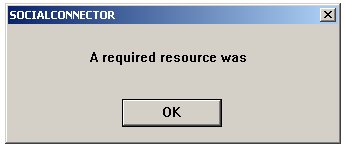After a few weeks of use, Microsoft Outlook tends in my experience to go into a kind of thrashing mode where the user interface no longer quite functions as it should, although to the tool’s credit it does not lose information. Recently I have been getting pop-up warnings such as
A required resource was what? The message reminded me of an episode in a long-ago game of Scrabble, in which I proposed ADOABOUT as a word. “Ado about what? ”, the other players asked, and were not placated by my answer.
The message must have been trying to say that a required resource was missing, or not found, but at the time of getting the final detail Outlook must have run out of UI resources and hence could not summon the needed text string. Not surprising, since running out of resources is precisely what caused the message to appear, in a valiant attempt to tell the user what is going on. (Valiant but not that useful: if you are not a programmer on the Outlook development team but just a customer trying to read email, it is not absolutely obvious how the message, even with the missing part, helps you.) The irony in the example is that the title bar suggests the problem arose in connection with trying to display the “Social Connector” area, a recent Outlook feature which I have never used. (Social connector? Wasn’t the deal about getting into computer science in the first place that for the rest of your life you’d be spared the nuisance of social connections? One can no longer trust anything nowadays.)
We can sympathize with whoever wrote the code. The Case Of The Resource That Was (Not) is an example of a general programming problem which we may call Space Between Your Back And Wall or SBYBAW: when you have your back against the wall, there is not much maneuvering space left.
A fairly difficult case of the SBYBAW problem arises in garbage collection, for example for object-oriented languages. A typical mark-and-sweep garbage collector must traverse the entire object structure to remove all the objects that have not been marked as reachable from the stack. The natural way to write a graph traversal algorithm is recursive: visit the roots; then recursively traverse their successors, flagging visited objects in some way to avoid cycling. Yes, but the implementation of a recursive routine relies on a stack of unpredictable size (the longest path length). If we got into garbage collection, most likely it’s that we ran out of memory, precisely the kind of situation in which we cannot afford room for unpredictable stack growth.
In one of the early Eiffel garbage collectors, someone not aware of better techniques had actually written the traversal recursively; had the mistake not been caught early enough, it would no doubt have inflicted unbearable pain on humankind. Fortunately there is a solution: the Deutsch-Schorr-Waite algorithm [1], which avoids recursion on the program side by perverting the data structure to replace some of the object links by recursion-control links; when the traversal’s execution proceeds along an edge, it reverses that edge to permit eventual return to the source. Strictly speaking, Deutsch-Schorr-Waite still requires a stack of booleans — to distinguish original edges from perverted ones — but we can avoid a separate stack (even just a stack of booleans, which can be compactly represented in a few integers) by storing these booleans in the mark field of the objects themselves. The resulting traversal algorithm is a beauty — although it is fairly tricky, presents a challenge for verification tools, and raises new difficulties in a multi-threaded environment.
Deutsch-Schorr-Waite is a good example of “Small Memory Software” as studied in a useful book of the same title [2]. The need for Small Memory Software does not just arise for embedded programs running on small devices, but also in mainstream programming whenever we face the SBYBAW issue.
The SBYBAW lesson for the programmer is tough but simple. The resources we have at our disposal on a computing system may be huge, but they are always finite, and our programs’ appetite for resources will eventually exhaust them. At that stage, we have to deal with the SBYBAW rule, which sounds like a tautology but is an encouragement to look for clever algorithms: techniques for freeing resources when no resources remain must not request new resources.
References
[1] Deutsch-Schorr-Waite is described in Knuth and also in [2]. Someone should start a Wikipedia entry.
[2] James Noble and Charles Weir: Small Memory Software: Patterns for Systems with Limited Memory, Addison-Wesley, 2001.




